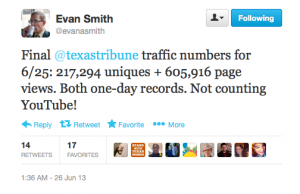
The Texas Tribune showed late Tuesday night and very early Wednesday morning how an online non-profit news organization can drive coverage of a story and leave legacy media to talk, literally, about muffins.
During one of the most climatic moments in Texas political history, The Texas Tribune owned the story, buoyed by its live YouTube stream of the Texas Senate in a tense countdown to the midnight end of a special session that included a 10-hour filibuster by new social media darling Sen. Wendy Davis and the debate about a controversial abortion bill.
More than 180,000 people were watching the live stream, taken from the Senate feed, when raucous pro-choice supporters verbally overcame senators as the session came to a close and Tuesday turned to Wednesday.
It wasn’t immediately clear if the measure passed. What was clear, and made apparent in many congratulatory tweets, was that The Texas Tribune won by producing compelling public-interest journalism.
The coverage was riveting and a lot of people were watching.
Evan Smith, the CEO and editor-in-chief of The Teaxas Tribune, tweeted that the site had 217,294 unique users and 605,916 page views Tuesday, which are both one-day records for the site that launched in 2009. Those numbers do not include the more than 180,000 live YouTube views (and there were likely thousands more viewers cumulatively). Wednesday’s numbers should be equally impressive.
Final @texastribune traffic numbers for 6/25: 217,294 uniques + 605,916 page views. Both one-day records. Not counting YouTube!
— Evan Smith (@evanasmith) June 26, 2013
The Texas Tribune is one of the new(ish) breed of public accountability journalism organizations that have found a niche covering issues that often have been forgotten by traditional media. Others include Pulitzer Prize-winning ProPublica, the Voice of San Diego and the stalwart Center for Public Integrity, which turns 25 next year.
Here’s how the Tribune describes itself on its website, texastribune.org:
“The Texas Tribune is a nonpartisan, nonprofit media organization that promotes civic engagement and discourse on public policy, politics, government, and other matters of statewide concern. Our vision is to serve the journalism community as a source of innovation and to build the next great public media brand in the United States.”
The journalists at The Texas Tribune met their goal brilliantly.
As newspapers were struggling with print deadlines, the cable news networks were running prime-time repeats, Dallas-Fort Worth TV stations were in late night shows and the Associated Press prematurely tweeted plainly that the abortion measure passed the Texas Senate, The Texas Tribune held legislators accountable and reported the vote occurred after the midnight deadline.
BREAKING: Republicans pass new restrictions expected to close almost every abortion clinic in Texas.
— The Associated Press (@AP) June 26, 2013
While many news organizations in the state were limited to a reporter or two in Austin, The Texas Tribune had a team of journalists on the story and up all night.
Of course, the Tribune had the benefit of reporting online and through social media. There was no stopping to make sure a print story was finished and they didn’t have to break into programming, they had been live streaming the entire 30-day special session.
For what it’s worth, during the height of this drama, CNN was airing a repeat of “Piers Morgan Tonight” with guest Dr. Drew Pinsky talking about the calorie count of Starbucks menu items, including a blueberry muffin containing 350 calories.
Non-profit news outlets won’t solve all of journalism’s challenges, but The Texas Tribune showed Tuesday night (and Wednesday morning) the importance of this brand of journalism.









How these non-profits organizations survive? Yea nowadays there are so many ways to read or watch news, and it’s getting more and more instant. I believe there are also quite a lot people there who are not so interested in politics, maybe there could be some other topics introduced, e.g. energy consumption, environmental assessment, etc.?
Nice write up Aaron. Superb stats for one day. They have made the most of their social media inter connectivity, which yields into such a big figure.
wow very nyc. i like it very much thanx for sharing
A very nice article , explaining the path of journalism nowadays
When everything is changing is a rapid pace, journalism also must adopt the change of pace with help of social media. Some organizations are implementing new strategies. That is good for journalism. We have to accept the change.